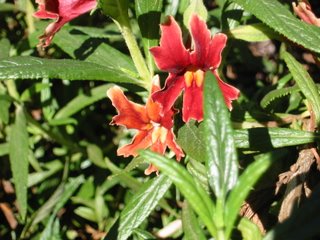March 2007 Native Harmony - “Perfect Plants for Hanging Pots”

Mimulus (species unknown) photo above.
If you’ve grown weary of the same old plant offerings at the nursery and are seeking something that will make a splash in a fabulous hanging pot, try one of these cascading California natives.
Arctostaphylos edmundsii ‘Bert Johnson’ or ‘Carmel Sur’ are two lovely low-growing manzanitas. ‘Bert Johnson’ has petite white flowers in spring, grows a bit slower and stays more compact (1’ high and 2’ wide) than ‘Carmel Sur’ (1-2’ high and 6’ wide), which has light pink flowers in the winter. Both are evergreen, attractive to hummingbirds and other birds, grow best in some shade around these parts and will put out adorable apple-looking fruits after flowering (hence the name manzanita, meaning little apple in Spanish). There are other manzanitas that will do well in hanging planters. Look for the ones that are classified as groundcovers; they will grow low and trail over the sides of pots.
Many of the Mimulus (monkeyflower) species are superbly-suited for suspension due to their habit of draping the area around where they grow. There are a wide variety of flower colors (white, yellow, hot pink, dark red, to name a few) from which to choose, making for fun plant selection. Most monkeyflowers need a little shade to flourish, especially when placed in a pot, and they are loved by hummingbirds, bees and butterflies.
Lessingia filanginifolia (California aster) ‘Silver Carpet’ (see a gorgeous photo of it here) is simply splendid spilling over the side of a hanging basket or other planter. Tolerating full sun during cool times of the year and needing a little shade in hot times, its silver, curled leaves sparkle in the sun and moon light. But they take a back seat in the spring and summer, when small daisy-like pale purple, yellow-centered flowers appear and are frequented by hummingbirds, bee and butterflies – all eager to gather the sweet nectar.
Last on this list but certainly not the last of the options is Epilobium/Zauschneria (California fuchsia), a feathery-leaved friend to the hummingbird with scarlet tubular blossoms in the late summer/early fall when there is little else in bloom. Like the others mentioned above, California fuchsia benefits from a partly shady exposure.
For all California native plants in hanging pots, use a standard potting soil, water when the soil is just about dry, fertilize once a year and transplant after a few years. Once the roots have maxed out their space in the pot, the plant will start to suffer. There’s not much else to do besides that. Just enjoy the sights these special specimens bring to your garden.

3 Comments:
My husband and I want to have Native California landscaping but have no idea where to start. Are there landcapers that specialize in this? Do we still need to begin with a sprinkler system? How do we start? Any information you could direct us to would be so helpful.
By Amy, at 10:09 AM
Amy, at 10:09 AM
Hi Amie,
I suggest you contact Theodore Payne Foundation. They can give you lots of info. Also, if you're wanting to start a native garden and are looking for inspiration, definitely check out the Theodore Payne Native Plant Garden Tour on April 28 & 29! Web: www.theodorepayne.org, phone: 818-768-1802. Good luck!
Monkeyflowerpl
By Mom 2 Miles, at 10:23 AM
Mom 2 Miles, at 10:23 AM
Mimulus aurantiacus, no?
By Raphael, at 9:36 PM
Raphael, at 9:36 PM
Post a Comment
<< Home